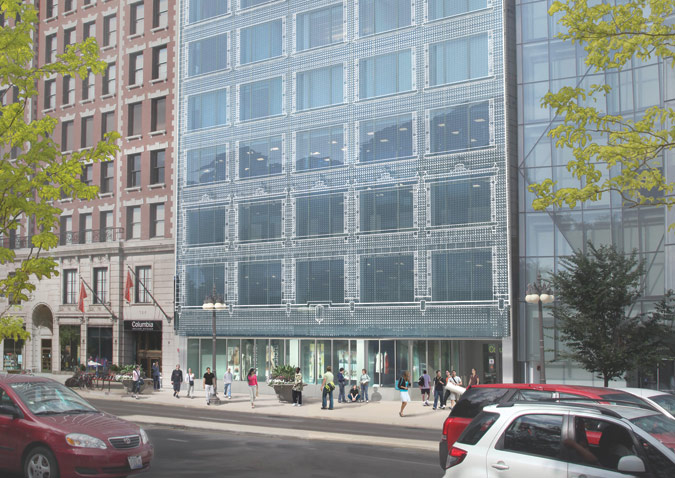
Sometimes ordinary facades conceal complex histories. Such is the case with the nondescript looking building occupied by Columbia College next to the Spertus Institute on South Michigan Avenue. The midcentury facade replaced the building’s eclectic original, which was designed in 1913, and now that that facade is failing Gensler has devised a solution that addresses the building’s history as well as its contemporary context.
Acknowledging the Michigan Avenue streetwall, a historic district with design review guidelines became the guiding principles of the design. The site, and much of downtown Chicago, is also in the migratory paths of many species of birds. Gensler’s highly efficient new double glass curtain wall features a pixelated image of the historic facade, rendered through a series of tiny bird silhouettes that will deter avian collisions.
|
The original 1913 facade (left), the Gensler proposal (center), and a detail of the existing facade (right).
|
||||
The architects located the building’s original drawings and then scanned them to help create a ghost of the historic facade that will be digitally printed on the new curtain wall. The design recently received approval from the Commission on Chicago Landmarks.
Also part of the context was Krueck + Sexton’s distinctive folded facade for the Spertus next door. “The budget is very tight, so we couldn’t do something like what Krueck + Sexton did,” said Elva Rubio, the project’s principal architect, referring to the Institute’s bold, contemporary facade which also received Commission approval. “We wanted to create a contemporary response that also referenced the past.”
The resulting facade is designed to be as clean and as minimal as possible. “The graphic will give it a sense of place,” she said. Gensler has worked on dozens of projects for Columbia, and previously renovated the entire interior of the Michigan Avenue building. “We’ve been helping them build an urban identity,” she said.